By Andrew Thomas
Our fighting soldiers – the recon units and scouts and expeditionary fighting forces that carry all of their equipment on their backs in and out of operations have learned this lesson well: ounces equal pounds. Soldiers have made an art of dropping unnecessary weight while in theater. They unpack their MREs just to ditch the large outer plastic bag. They forego conveniences and luxuries like an extra pair of briefs. They discard expensive equipment in the field; radios, gas masks and med kits; equipment they may need. Some cut their toothbrush in half – if they carry one at all. Sometimes they choose to carry less than they should of essentials like food, water, and ammunition. These combined efforts can result in dozens of pounds less to hump in a pack. Government contracted arms manufacturers have spent millions in research and development in attempts to lighten the load of our soldiers. The LSAT weapon project is a good example by cutting the weight the M249 SAW gunner had to carry nearly in half. It is based loosely on the M249 envelope, and uses caseless ammunition. Long before that, in the mid-1960s, Colt made the Model 608 Survival Rifle, based on the M16. They managed to whittle off unnecessary weight to bring it from 6 down to 4.8 pounds. It was intended to be carried in aircraft, in case of a crash, so flight crews could fight their way back to friendly lines. Before that, the M1 .30 carbine was the answer to the Garand’s size and weight; it was 25% shorter and 40% lighter than the Garand. It was ideal for personnel that were engaged in tasks other than direct combat. Mortar, tank, artillery, transport and support personnel found its size and weight preferable, and its capability sufficient. “Lightweight” is not a matter of convenience; it’s becoming quite necessary. This is the kind of thinking that spawned what is currently the world’s lightest AR-15 rifle, which weighs under four pounds.
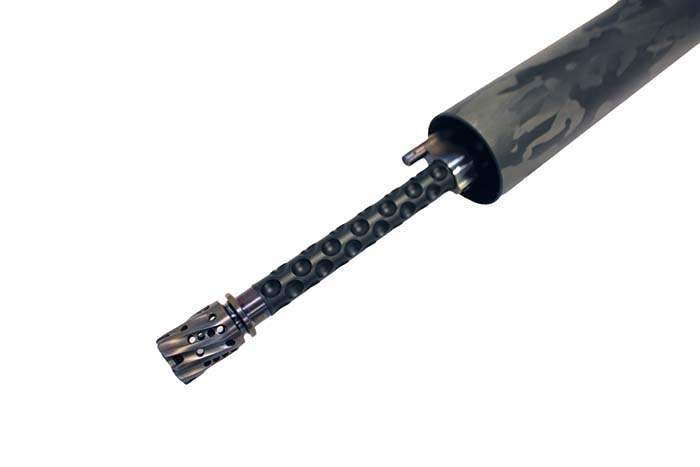
It’s called the OIP (ounces is pounds) and it is indeed the lightest AR-15 carbine manufactured today. It is a full size carbine – not an SBR (short barrel rifle) and not a pistol. It’s built up to a standard; not stripped down to a compromise. The grip is the only plastic on the gun. The receivers and buttstock and buffer assembly are made of 7075 T6 tempered aluminum that is type III hard anodized on all surfaces. The upper features a dri-lube film inside. The muzzle brake and gas block and pins and screws and bolt carrier are bare heat treated titanium. The forearm is filament-wound carbon fiber. The barrel is nitrocarburized ordnance steel. There is no next generation rare earth element found on this gun. It’s not the product of quantum chemistry or other witchery. It’s the result of a “basic” AR-15 being stripped of the inferior and upgraded with the superior. It’s what happened when some mad gunsmiths got together and decided to affect a shift in the way we think about firearms.
The “blue sky” thinkers we refer to are the men of Bentwood Gunsmithing, in Henderson, Nevada. Bentwood is for the most part a general repair shop. They indeed offer service and repair on guns to walk-in customers. They can also authoritatively build, create, modify, and improve weapons of all platforms; for all purposes. They sponsor a few of the world’s top action shooters; the guns wielded by those champions are made at Bentwood. They build and maintain duty and service weapons for many departments and agencies; foreign and domestic. It’s not enough to say that Bentwood’s staff is factory trained: it is actual fact that security, police, and military agencies and firearm manufacturers send their technicians to receive armory training from the man in charge at Bentwood Gunsmithing, Matthew J. Babb. Through experience, interaction, and feedback from such a broad industry sample, Bentwood’s Gunsmiths have learned what is required of a gun; and where the gun falls short of fulfilling its role.
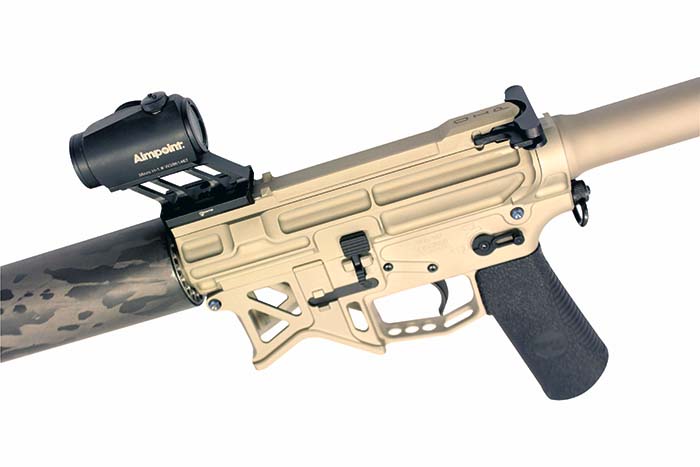
The first prototypes of the OIP project began in 2009 at the request of an Army Ranger that returned home from Afghanistan. This Ranger had carried a MK48 machine gun for several years in theater. It was heavy and unwieldy. The Ranger offered up the idea to Dave Lake, one of Bentwood’s Gunsmiths, to build a rifle that was “just a rifle.” Those were his words. He wanted a rifle that consisted only of what’s necessary to fire bullets safely, reliably, and accurately. The Ranger wanted a rifle that he could carry while biking or jogging in the woods. This idea of ultimate simplicity in a rifle became Dave’s mission. The early versions were built on vintage Colt AR-15 receivers – the old uppers without forward assist and shell deflector, and lowers without pivot pin plungers and fences. These receivers were fitted to pencil thin, shortened barrels. Thin wall tubing was welded on the muzzle to make legal length. Later versions of the lightweight project involved skeletonizing the receivers. Instead of using commercially available buffer and stock assemblies, the buffer from a carbine was used, as it weighs less than that of a rifle; while the tube from a rifle was used, as it weighs less than that of a carbine. A hollow plastic spacer below the buffer assembly is all that was needed to make this combination work. The barrel was aggressively fluted – more flute than barrel and a lightweight carrier installed. The takedown pins and selector barrel were hollowed out. The gas block was condensed to one fourth the bulk of the lightest commercial option. Even the hammer and trigger were ground down to a third their original thickness while preserving proper function. Sometimes each new effort would show a loss of an ounce or two; though sometimes progress came only in fractions of an ounce.
In the summer of 2013, Bentwood Gunsmithing partnered with Battle Arms Development to create an ultra-lightweight receiver set dedicated to this project. The result bore the compelling strut-and-web design seen here. Careful engineering created a receiver set slightly stronger than a basic forged receiver set, and 30% lighter. The barrel was optimized by incorporating a unique machine dimpled surface. This patented feature is used under license granted by Knight’s Armament Corporation. The dimpling process retains most of the barrel’s rigidity while cutting the barrel’s weight from the typical 28 ounces to a scant 18 ounces. During its development, as the rifle dropped below the 5 pound mark, there were resultant negative side effects. Recoil was uncomfortable and handling during fire became strained. The OIP’s control and firing characteristics would need to be improved, while maintaining a net weight loss.
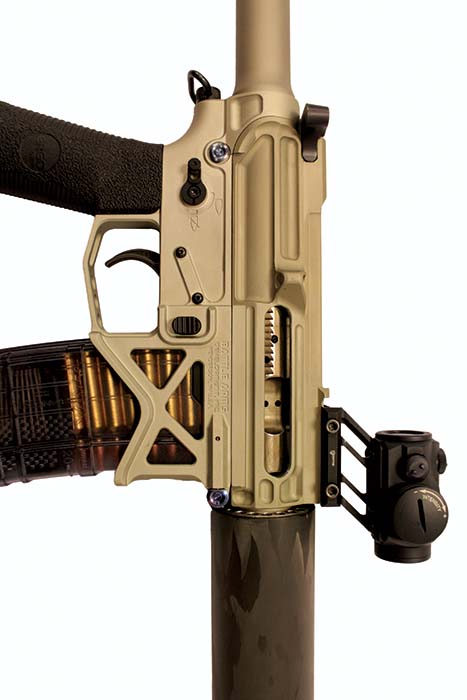
The OIP, in its final revision, weighs just under 4 pounds dry. More effort is required to pull the trigger on a Glock pistol than lift this rifle. This lack of inertial mass makes a brusque recoil impulse and there were corrective measures applied to the gun to keep it under control. First, and most obvious, is the muzzle brake. It’s machined from titanium bar stock. Its weight is half that of a steel brake. The porting and internal geometry are not random. The design is the product of thorough testing, study, and experimentation. There is no equation that can be applied to calculate the dynamics of a muzzle brake; and no broad definition to quantify the effect. Caliber, chamber, bullet weight, barrel length, gun weight, gun geometry, shooter weight and stance and method of holding the gun all skew the result. Empirical data was gathered from many prototype brakes as over 1,000 rounds of M855 ball were fired in front of a slow motion camera from a “recoil machine,” a fixture built by Bentwood specifically for this project. During their work, Bentwood discovered that a muzzle brake works by two principles. They are described as the flow and foul of a gas (exiting the muzzle). More of the “flow” effect built into a brake’s baffles and chambers results in a slower; albeit still present, recoil impulse. This style returns less overall effective recoil attenuation for small calibers. It works well with heavier weapons, and larger cartridges. The property of flow can be exploited as directional control, to counteract muzzle rise for instance. The “foul” effect can create highly effective recoil control; sometimes too much. In the case of this 4-pound rifle, one overly effective brake originally used for testing actually yanked the rifle forward – away from the shooter – making follow up shots next to impossible. A “fouling” brake also makes for an overwhelming blast impulse back to the shooter. The result of these efforts is a brake that is balanced in its effect to work optimally with this rifle.
More recoil mitigating features are found on the other end of the gun. The proportion of the stock assembly is the result of some trial and error and some consultation with some experienced professional shooters. It is an accepted fact that there is a proper way to “saddle” a rifle. By doing so, the shooter effectively gains more control over that rifle. This method asks that the shooter mount the rifle low in the shoulder, while keeping the body square to the direction of fire. The head should remain upright and rest forward and atop the stock. The length and drop of the OIP’s stock were devised to encourage correct shooting form; and as part of its design, is meant to cause discomfort if the rifle is held incorrectly. The pistol grip also plays its part. As it is nearly vertical, it encourages the arm to swing farther forward, resulting in a better “pocket” in the shoulder for the stock to lock into. It also lets the hand and wrist relax more than a rearward swept grip; facilitating better trigger control. Other secrets lie inside the OIP’s buffer tube. The buffer’s design has been enhanced from the standard configuration. The details of these structures will not be illustrated here; suffice to say that cyclic function and recoil impulse are optimized while achieving an overall weight savings. The recoil spring system, called the “Flatline” is available as an accessory to be used in any AR-15. It is perhaps the smartest part on this rifle. It replaces a conventional buffer spring with 3 new components; 2 springs and a little plastic ring. It’s so simple but so effective. The motion of the recoiling mass of the bolt group and buffer is attenuated by multiple springs that slow and reverse motion at multiple rates. The result is a rifle that operates near the constant recoil principle, with enhanced reliability, and with almost no recoil energy passed on to the shooter.
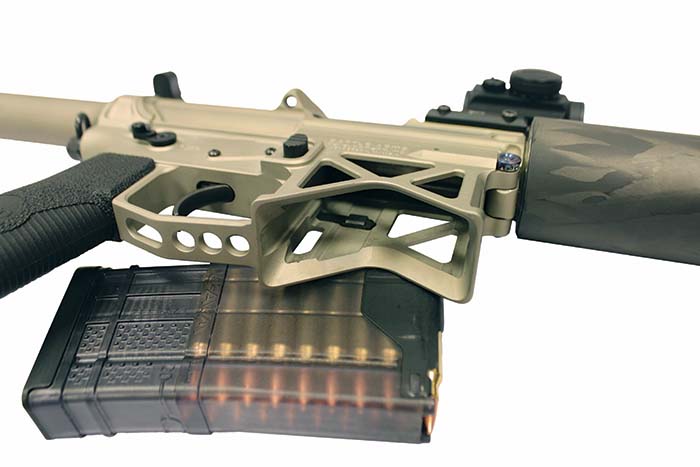
The OIP is offered for sale only as kit, though some of the developments will be for sale as accessory items later this year. The kit includes an optic, optic mount, sling, magazines and a discreet carrying case. The optic is the Aimpoint H1. It is not the lightest red-dot on the market; it was chosen for being the best red-dot that is light. Weight savings was a goal in the OIP project, but it never came at a compromise to the rifle’s function. The magazines included are made by Lancer Systems. They are indeed lighter than any metal magazines and come at a weight savings while maintaining reliability. Lancer Systems magazines are transparent polymer, and feature a metal top section that includes the feed lips and notch for the latch. Here again, weight was dropped without sacrificing function. The case was chosen for its utility as a multipurpose pack. It does not look like a gun case. It can be carried in the hand or slung over shoulder or across the back. It’s meant to blend in among gym bags and backpacks we might see attached to joggers, bikers, and commuters these days. It features padded exterior walls, many compartments and a place for a hydration bladder. The rifle is stowed in a broken-down state in the main compartment. The sling is an elastic single point style without padding; it’s simply not required. This rifle could be carried comfortably on a single strand of para-cord.
The small bits on the OIP are all very special as well. The titanium gas block is almost not there – it weighs less than the gas tube. The forearm is glued to the barrel nut as screws would be too heavy. The takedown and pivot pins are titanium and available from Battle Arms Development as the TiEPS. The screws that hold the grip and buttplate are also titanium. The selector lever is another Battle Arms part; their short throw modular unit; though the OIP variant is made of skeletonized aluminum. JP Rifles supplies the OIP with its trigger mechanism. It offers a 4 pound pull with adjustable sear engagement, pre travel and over-travel. It’s also the thinnest trigger on the market, thus it is the lightest trigger on the market. The bolt carrier is machined from solid titanium. The bolt and gas key are nickel boron coated, magnetic particle inspected, Carpenter 158 steel. The entire assembly is of premium quality and workmanship. This bolt carrier group weighs 4 ounces less than a regular steel bolt group.
The OIP is somewhat limited in its mission adaptability. It cannot accept forward Picatinny rail sections. It is not compatible with M-lok or Keymod accessories. The only upgrade is an optional flashlight mount that connects to the Fortis Scope base. By locating the light just ahead of the receiver and atop the forearm, the rifle’s balance remains manageable, and gives the user’s thumb direct access to the light controls. Through its evolution, the OIP has become a narrowly focused weapon. It’s built for long term carry, rapid deployment, and the aggressive use against armed threats. It really belongs to those who need to carry a weapon all the time – security guards, standing a post or traveling with a VIP, police officers on bicycles, and even the Secret Service. Any of the alphabet agencies could use it to good effect. Law enforcement and anti-terrorism groups are encountering an ever- growing domestic threat. The convenience and concealability of the handgun is becoming overshadowed by its limited range and power. Those that serve in our defense need real firepower at their side. There is a demand for, and a growing supply of small, potent weapons that punch above their weight and bridge the gap between pistols and assault rifles; known generally as PDWs. The poster child of this type of weapon is the Heckler and Koch MP7. It ignores the line between the sidearm and the assault rifle, is lethal up to 200 meters and boasts armor-piercing capabilities. It carries a 30-round magazine of hi-velocity .18 caliber projectiles, and can fire them in full auto at 950 rpm with no appreciable recoil. The operator does require extensive training and familiarization to put the MP-7 to good use. It is roughly twice the size and weight of the average service pistol; it weighs 4.2 pounds empty. Well then, we see now that there is a balance to be reached between size and weight and firepower and practicality. The OIP weighs 4.2 pounds with the aimpoint attached. The 5.56mm ammunition is well proven; and the AR-15 platform is well known. The AR-15 platform requires no new level of training, no new armory certification, and can use common parts and common ammunition. The 5.56 cartridge doubles the range and effect of the 4.6mm round used in the MP-7. In a world where insurgents often present with submachine guns and assault rifles, our counterinsurgent forces should, if at all possible, out-gun the bad guys. “Too much gun” is just a negative way of saying, “decisive application of force.” Comparatively then, the only drawback to the OIP is its size; a flaw easy to overlook when weighed against the advantages the OIP affords its user.
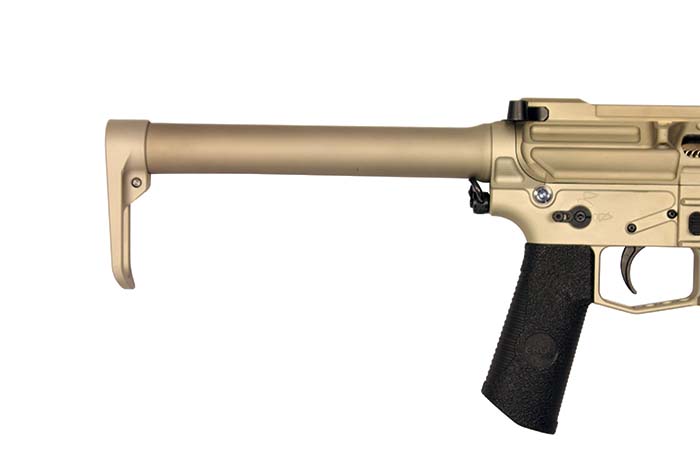
Our evaluation at the range did not disappoint. We were quickly mobbed by other shooters and range staff; all very curious about the rifle. They were all caught completely off-guard when we passed the rifle around for close-inspection. The “gallery” we had attracted became abuzz in comment about the OIP’s feather-lite feel and perfect balance. For some, the looks of the gun caught them; it was love at first sight. There were members of this crowd that were skeptical, so we gave them all a chance to fire it. One way or another, by holding, firing, or merely looking at the OIP, everybody at the range that day became a believer. After we shot the gun, any dubious feelings we had about the OIP were put to rest as well. Bentwood’s claims of superior balance, ergonomics, firing and handling characteristics are all very true. If we didn’t know any better, we would swear that every bit of R&D went into making this thing perform. The exquisite form the rifle has taken could just be a fortunate side effect. And what’s satisfying is that it’s not made of techno-fluff and rainbows like some boutique AR-15s can be these days. The OIP is a real player. It meets or exceeds accuracy standards set forth for the M4 carbine. Our test rifle came fitted with an Aimpoint H1 red-dot. There is no place for a magnifier on the receiver, so our long range accuracy results would be achieved without magnification. Standing unsupported at ranges up to 300 yards, we could easily deliver all hits “in the black” on an NRA B27 silhouette target. At 100 yards from a rest, using M855 ball ammunition, our best groups averaged 3-inches on target. For close-in rapid fire results we used a shot timer set to a par time of 1 second per target placed downrange. Even on targets out to 50 yards, we were able to make our hits and transitions within our timed goals. This speaks to the rifle’s superb handling traits. Moving the OIP from target to target is really as easy as looking at the next target. The rifle instinctively follows and there’s so little effort required to move it with zero recovery time between shots. This kind of speed and handling is just what 3-gunners are seeking. The properties of all metal parts and surface coatings exceed our military’s operational standards for wear, abuse, and normal operation. After over 1,200 rounds at the range over two days, including all the shooting by the folks at the gun range, there were no jams, failures, or malfunctions of any kind. Our evaluation took two days because of the severe weather of the Nevada desert in fall. The first day saw high winds and dust, followed by torrential rain that combined with the dust to form mud. Perfect opportunity to tempt fate; the gun was not cleaned before day 2 yet we finished our range testing without a hitch. This does not suggest that the OIP is superior in this capacity as the limits of the AR-15’s ability to survive abuse have been long established on the battlefield. We don’t suggest that Las Vegas is as bad as Afghanistan or Panama, but it is one of the harshest places in North America, and that’s a good enough test for most of us. So the OIP is as good as any other good AR-15 at roughing it in the elements. If we must complain about something, we will complain about the very hot forearm. During fire, the black carbon fiber tube absorbed radiant heat from the barrel and the desert sun like a charcoal briquette. We urge the use of a glove for sustained fire, or use the “magwell” grip with the front hand. At our inquiry, we were told by Bentwood Gunsmithing to expect other versions and caliber options in the future. They declined to let slip any dates or details. We’ll cross our fingers for a 300 Blackout or even a pistol variant. It would be selfish to hope for an AR-10 to receive the OIP treatment.
The OIP is produced in very limited numbers, and each rifle is assembled by one man and inspected by the other at Bentwood Gunsmithing. The OIP is unique, exclusive, beautiful, and powerful. It’s a rare thing that is as intriguing to see and hold as it is to shoot. It’s like a greyhound; skin and bone and muscle that was built to run. This rifle begs to be taken to task. But like most of your guns, you don’t buy them out of necessity. You’ll buy the OIP to make your shooting buddies jealous. You want to be the object of envy at the shooting range. You don’t have to carry a badge and wear a suit and sunglasses and an ear bud and speak into your cuff to justify buying it; but if you are lucky enough to get an OIP, you’re welcome to don the sunglasses and ear bud.
| This article first appeared in Small Arms Review V19N1 (January 2015) |











